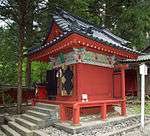Futarasan jinja
| Futarasan jinja 二荒山神社 | |
|---|---|
|
The Sacred Bridge, part of the Futarasan Shrine. | |
| Information | |
| Dedicated to |
Ōkuninushi Tagorihime Ajisukitakahikone |
| Founded | 767 |
| Founder(s) | Shōdō Shōnin |
| Address | Nikkō, Tochigi |
| Website |
www |
|
| |

Futarasan jinja (二荒山神社) is a Shinto shrine in the city of Nikkō, Tochigi Prefecture, Japan. It is also known as Nikkō Futarasan Shrine, to distinguish it from the shrine in nearby Utsunomiya. Futarasan enshrines three deities: Ōkuninushi, Tagorihime, and Ajisukitakahikone. It is located between Nikkō Tōshō-gū and the Taiyū-in Mausoleum. Many visitors go to all three, as well as to Rinnō-ji.
Together with Nikkō Tōshō-gū and Rinnō-ji, it forms the Shrines and Temples of Nikkō UNESCO World Heritage Site. The shrine possesses two swords that are National treasures of Japan. Additionally, dozens of buildings and cultural artifacts are listed as Important Cultural Assets.
The Sacred Bridge (神橋 shinkyō) crossing the Daiya River belongs to the Futarasan Shrine. This beautiful vermilion lacquered structure is known as one of the three most beautiful bridges in Japan and is a perfect gateway for Nikko. The bridge was registered as a World Heritage in December 1999. Shinkyo measures 28 meters long, 7.4 meters wide, and stands 10.6 meters above the Daiya River.
According to legend, a priest named Shōdō and his followers climbed Mt. Nantai in the year 766 to pray for national prosperity. However, they could not cross the fast flowing Daiya River. Shōdō prayed and a 10 foot tall god named Jinja-Daiou appeared with two snakes twisted around his right arm. Jinja-Daiou released the blue and red snakes and they transformed themselves into a rainbow-like bridge covered with sedge, which Shōdō and his followers could use to cross the river. That is why this bridge is sometimes called Yamasugeno-jabashi, which means the "Snake Bridge of Sedge".
The Shinkyo has been rebuilt many times but has followed the same design pattern since 1636, when it could be used only by messengers of the Imperial court. It has been opened to the general public since 1973.
History
The shrine was founded in 767 by Shōdō shōnin (勝道上人). The shrine takes its name from Mount Nantai, which is also called Futarasan (二荒山).
Yayoi period
Archeologists affirm that during the Yayoi period the most common go-shintai (御神体) (a yorishiro housing the enshrined kami) in the earliest Shinto shrines was a nearby mountain peak supplying with its streams water, and therefore life, to the plains below, where people lived.[1]
Mount Nantai constitutes Futarasan Shrine's go-shintai, and the shrine is an important example of this ancient type of mountain cult.[1] Significantly, the name Nantai (男体) itself means "man's body".[1] The mountain not only provides water to the rice paddies below, but has the shape of the phallic stone rods found in pre-agricultural Jōmon sites.[1]
Heian period
Futarasan was designated as the chief Shinto shrine (ichinomiya) for the former Shimotsuke province.[2]
Meiji-Showa periods
From 1871 through 1946, Futarasan was officially designated one of the Kokuhei Chūsha (国幣中社), meaning that it stood in the mid-range of ranked, nationally significant shrines.
Photo gallery
 The main hall (honden) lies within the enclosure.
The main hall (honden) lies within the enclosure. Haiden
Haiden Building housing mikoshi
Building housing mikoshi Hie Shrine
Hie Shrine Chinese-style lantern, the Bake-doro ("Ghost Lantern")
Chinese-style lantern, the Bake-doro ("Ghost Lantern") Daikoku-den 大黒殿
Daikoku-den 大黒殿 Mitomo Jinja
Mitomo Jinja Other buildings at Futarasan Shrine
Other buildings at Futarasan Shrine The gate leads to the precincts of the shrine
The gate leads to the precincts of the shrine
See also
Notes
References
- Brown, Delmer M. (1993). The Early Evolution of Historical Consciousness in "Cambridge History of Japan", Vol. 1. Cambridge, New York & Victoria: Cambridge University Press. ISBN 978-0-521-22352-2.
- Encyclopedia of Shinto, Nikkōsan shinkō accessed on September 20, 2009
- Iwanami Kōjien (広辞苑) Japanese dictionary, 6th Edition (2008), DVD version
External links
- UNESCO document: Advisory Body Evaluation
- Futarasan Shrine official Web site
- Tochigi Jinja-chō
- Nikkō National Park official Web site
| Wikimedia Commons has media related to Futarasan Shrine. |
Coordinates: 36°45′30″N 139°35′47″E / 36.75833°N 139.59639°E